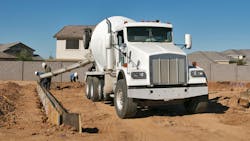Industry analysts and researchers have predicted a 2025 trucking economy upturn for months, but with only small signs of improvement, other analysts have predicted the upturn to happen in 2026 and 2027. Do recent industry events indicate a sure sign of improvement to come in 2025?
ACT Research’s president and senior analyst, Kenny Vieth, recently spoke about the current economy, how we got here, and what we can expect for the next year. His prediction: Trucking will experience an upturn for 2025, especially with the medium-duty and vocational segments.
Current trucking economy
The trucking industry goes through typical cycles of highs and lows; however, this particular slump has lasted years as opposed to the usual months. While the overall economy has remained resilient to inflation and fought off a recession, the trucking industry has remained unsettlingly flat.
“Even though the US economy grew in 2023—2.5%—the freight components of the economy did not grow,” Vieth said during the Motor and Equipment Manufacturer’s Association’s commercial vehicle outlook conference, noting a 21% contraction in the overall freight industry for the year.
This 21% contraction came the same year that the overall number of in-use tractors increased by 4%, Vieth explained.
“Herein lies the problem,” he said. “Equipment oversupply is weighing on carrier profitability.”
See also: Survey says: Freight recovery begins with small gains
How did we get here?
It’s no secret that would-be truckers flocked to the industry during the heyday of 2021, which led to the industry’s excess capacity. Now because the amount of freight being shipped is less than the amount of trucks available to ship it, carriers are feeling the strain.
Freight rates have lagged behind inflation, and overcapacity within the trucking industry is the largest contributing factor to bottomed-out rates. Numbers from Q2 2024 signal that carrier profitability is currently at its lowest since 2010, Vieth said.
That 4% increase in tractors on the road could be attributed to the growth of private fleets—those that are also grabbing market share from for-hire carriers, Vieth explained. This private fleet growth was due to the explosion in freight rates of 2021, as it necessitated the need for companies to take control of their own supply chain.
Companies that required shipments for their business developed “their own fleets, handling both inbound and outbound shipments, simply to ensure their products remained on store shelves or ensure they were able to manufacture their goods, Tom Moore, executive VP of National Private Truck Council, said during a media briefing of the Council’s annual report.
Secondly, there is a “record-high valuation spread” between the price of new and used trucks coupled with high interest rates and a tight credit environment. Then, there are vehicle and trailer inventories, which Vieth said are at record highs relative to sales.
“The good news is the OEMs, both truck and trailer, are cutting production,” Vieth explained. “You have to fix the problem, the OEMs have to reign in production, and that is what we’re seeing occurring.”
While the decrease in production isn’t good news for every industry player—Vieth was speaking at a supplier-focused conference, after all—it should contribute to a better trucking economy in the months ahead.
See also: Milestone rate improvements signal freight recession receding
But how can all of this signal good news for the medium-duty and vocational segment?
2025 vocational and medium-duty outlook
Government spending drives growth
The trucking industry has been vocal about its criticism of the U.S. government with emissions rules, labor rules, and tariffs on goods moved by the trucking industry, but the government is spurring the predicted success of the vocational and medium-duty segment.
The inflation reduction bill and infrastructure bill introduced trillions of dollars into the market. These investments have propelled construction projects and utility projects across the nation.
This includes electrical power grid upgrades along with construction plans to build out a nationwide grid that can sustain the mass adoption of electric vehicles.
Building out the grid will require “very good, big construction projects to drive that, especially heavy duty, vocational tailwinds,” Vieth said.
Once that grid is built out, it will require trucks to manage it. Forecasters at S&P Global Mobility predict the Class 5 truck market to thrive next year, as outlined by its 2025 truck market outlook report.
“Class 5 trucks are increasingly important for utilities and municipalities, and as the population grows in North America, the demand for these commercial trucks is expected to increase,” the report states.
Further, “we’re still in the early innings” of spending stimulus money, Vieth said. “The CHIPS program, we've spent about 22% so far; and the Inflation Reduction Act, only about 17% of that has been put into play; and the Infrastructure and Jobs Act—just a little over 50% of that money” has been spent—meaning that we can expect more projects in the future.
See also: Feds fueling $8B nationwide hydrogen hub investment
Manufacturing and consumer spending
U.S. manufacturing is also growing. Trucks are bringing supplies and equipment to the construction sites of manufacturing facilities, Vieth said, and once those facilities are operational, trucks will be used to transport the goods manufactured in those facilities.
Ultimately, consumers will drive the demand and growth of the medium-duty segment, Vieth shared. While inflation remains high, U.S. households have more cash today than they did 10 years ago.
“In 2014, U.S. household wealth was about $75 trillion,” Vieth said. “This year, currently, U.S. household wealth is about $150 trillion.”
That $75 trillion in 2014 equates to nearly $100 trillion in 2024 when adjusted for inflation. As consumers buy more goods, the medium-duty segment—most prominently in the delivery space—will likely see growth. Consumers also help spur the vocational segment when they buy and build houses.
Further, “interest rates might see a downward adjustment in the latter half of 2024, which could also stimulate a faster-than-expected rebound,” the S&P Global outlook report states.
Additionally, Vieth said that in 2025 OEMs will begin targeting the vocational segment as potential customers.
“In 2024, the OEMs very aggressively went after private fleets to get them to buy tractors,” Vieth explained. “We believe that this year it appears that, looking at good support and good financials, the OEMs are likely targeting vocational markets in 2025.”
It’s also worth noting that vocational truck orders in September 2024 were the highest they’ve ever been at 20,000 orders. This number represents a 71% year-over-year increase in vocational truck orders. This could be due to pent-up demand brought upon by supply chain woes from the pandemic, or it could signify the beginning of the 2027 pre-buy, Vieth said.
While Vieth and the S&P forecasters’ predictions focus on the next year, other analysts, such as consultants with Fundamental Business Insights, predict the medium-duty segment to grow substantially by 2032.
The medium-duty segment crossed $51.8 billion in 2023, and the FBI predicts it will be valued at $85.31 by 2032. FBI cites the growth in e-commerce, the focus on sustainability and fuel efficiency, and the trend in urbanization as the segment's top factors to growth.
Though the industry has seen its share of grim operations throughout the past few years, there are green shoots.
While tractor capacity moderation will come “too late to save 2025,” Vieth explained, “on the flip side, investments and services tailwinds are good for medium-duty and heavy-duty vocational.”
About the Author
Jade Brasher
Senior Editor Jade Brasher has covered vocational trucking and fleets since 2018. A graduate of The University of Alabama with a degree in journalism, Jade enjoys telling stories about the people behind the wheel and the intricate processes of the ever-evolving trucking industry.


